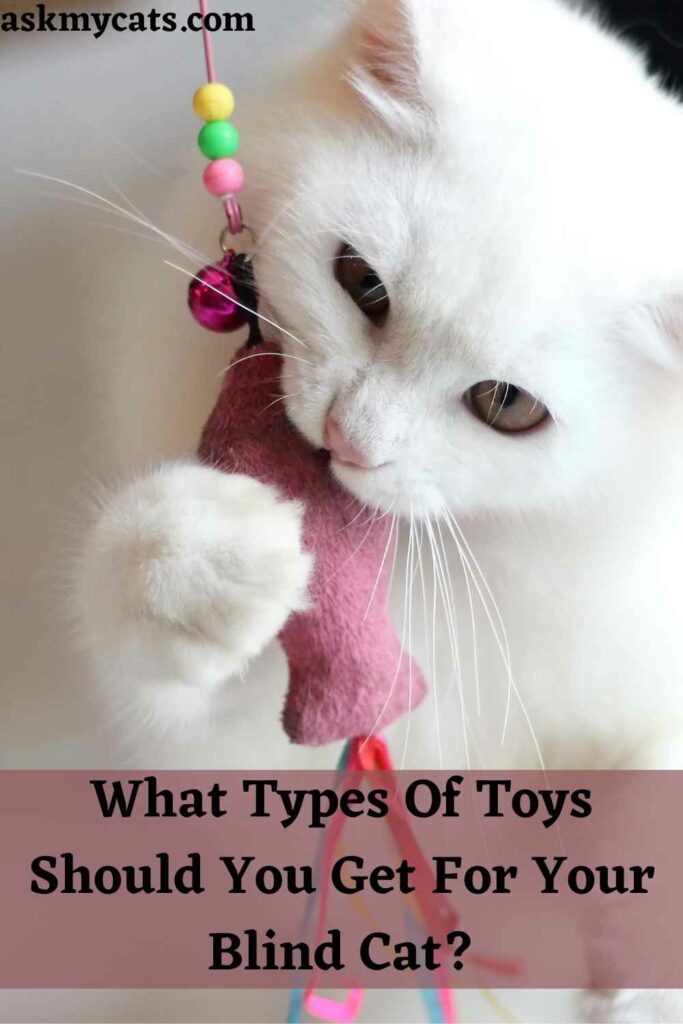Cats can be born blind or might become blind in later stages of their life, whether it’s suddenly or gradually. Although it is rare for a cat to become blind to age-related problems, it could happen.
Fortunately, a blind cat is able to live a happy and fulfilled life with some adjustments made by you. Cat training builds confidence and keeps a cat both physically and mentally fit. It also aids in the bonding of a cat and her human. Just like a sighted cat, a blind cat can benefit from training sessions.
This article will tell you all about training your blind cat and its benefits.


Give Your Cat the Perfect Day
Get the Free Ebook!
How To Train A Blind Cat?
The best way to train a blind cat is through clicker training and associating a word like “watch” and saying that again and again just before your cat is going to bump into something.

Clicker training is beneficial for all cats, but it is especially beneficial for blind cats.
The clicker’s noise can indicate to the cat she’s doing the proper thing much faster than you could otherwise.
Use simple orders that you say the same way every time. “Watch” is an excellent command to teach your blind cat.
Use a clicker and treats to educate your cat that she should slow down and change courses since she’s about to collide with something when you say that phrase.
Cat training offers advantages beyond simply teaching your cat to sit. You’re stimulating both his body and mind, which is beneficial to his overall health.
Mental stimulation will keep him feeling enriched and exhausted, resulting in a cat who is less prone to engage in common nuisance behaviours as a result of boredom.
Yes, training can help if your cat has a habit of knocking things over and creating noise late at night. Furthermore, training can assist your cat in developing a better relationship with people, lowering fear and negative behaviours like aggression.
Clicker Training
While there are a few ways to train a cat, blind cats have even fewer options. The ideal way to ensure that your cat wants to learn is to use clicker training. Positive reinforcement is used in this training to teach cats how to learn to overcome the communication gap between cats and people.
Your cat will learn more quickly if you employ clicker training. Food and play are two of the most potent motivators for cats.
When you produce a specific sound, such as a click, when your cat does something you want him to do, then match it with his favourite treat, the cat will want to repeat the activity because it was rewarding.
A bridging signal is the sound of a click. It informs your cat that he has done something deserving of a treat. This will encourage him to repeat the behaviour in order to receive another reward.
Because you can’t supply the treat as quickly as your cat can do the task, the click provides him with the information he needs to know the treat is on its way.
The timing of the click is critical, especially with cats, who offer action fast and seek immediate gratification.
What Is A Clicker
A typical clicker is a small plastic box that fits in the palm of your hand and contains a metal tongue that you press quickly to produce a “click” sound.
Because the sound of a typical box clicker can be intimidating to certain cats, some clickers feature a smoother sound that cats may find more appealing.
With clicker training, you can teach your cat everything from the basic sit and stay to more amusing tricks like a wave and return.
Target Training
This is incredibly crucial because you don’t want to deliver food rewards with your hands to a cat. While most dogs are gentle with treats, cats are not.
A wooden spoon, a baby spoon, or a thin dowel rod can be used to form a target stick. Tape a spoon to one end and your clicker to the other. Because of their long handle and a small spoon, baby spoons are ideal.
Simple Procedures for Teaching Your Cat to Target:
- Place some canned cat food or a mushed treat on the spoon (so it has traction).
- Show your cat the spoon filled with treats. Click when your cat approaches the food, and then let him eat a little.
- Repeat this process 3-5 times to ensure that your cat understands that following the spoon is rewarding.
- Make a left or right movement with the spoon. Allow your cat to consume some of the food in the spoon when he follows the spoon.
You may now use this spoon as a target for your cat, allowing you to teach him a wide range of new behaviours via clicker training.
Can Blind Cats Still Play?
Yes, blind cats certainly can still play as they require mental stimulation, just like all cats. The best products for blind cats are sensory toys that mimic prey.
When you’re playing with your blind cat, use sound toys. You can also make sounds by clicking wand toys on the floor.
Blind cats can adapt to any surroundings if given the proper care, nutrition, and attention. They orient themselves using their senses, and once they’ve done so, they act like any other cat.
Blind cats enjoy playing as well as lounging around. Toys that a blind cat can hear or smell are more useful and enjoyable to play with.
What Types Of Toys Should You Get For Your Blind Cat?
The toys you can get for your blind cats should have a sound or strong smell.

Other senses become stronger for the feline species, much as they do for a sight handicapped or blind human.
To survive, a cat must rely on its senses of smell, hearing, touch, and vibrations, and blind cats do exceptionally well.
While blind cats do incredibly well indoors, memorising where objects are located and remembering distances for leaps on the bed or the width and depth of steps, toys, and playing can get a little boring if the wrong toys are selected.
When a cat loses its vision, the other senses kick in, therefore toys with a strong sense of scents, such as catnip and valerian, or toys that create a sound, such as rod toys with bells on them, or a ball with a bell, can be pretty entertaining.
Even textured toys like fur or cardboard puzzle toys like a toilet roll sealed on both ends with holes in the centre and goodies inside may be a lot of fun to bat around with the smell of the treats as a guide.
Some cats can sense some light if they aren’t entirely blind; therefore, any ball toys that emit light are ideal.
When we talk about climbers, blind cats, like other cats, can judge distances quite well. To lend a helping hand, you would focus on cat trees with a ramp or platforms that are close together.
Scents like catnip leaves, favourite treats, or the jingle jangle of a favourite toy can all be used to entice your cat onto a cat tree.
They’ll quickly become accustomed to exploring their new cat tree and to the distances between the platforms.
Even when blind, some cats can be walked on a leash. It all depends on whether or not the cat is self-assured and shows symptoms of wanting to go outside.
Why not, if the street outside is quiet and your cat has responded well to lead training and has expressed an interest in exploring a little outside. Allow them to guide you.
Can A Blind Cat Use A Litter Box?
Yes, with a few adjustments, a blind cat can use a litter box. You can put a mat in Infront of the litter box so that your cat knows where is the litter box whenever the floor texture changes.
Keep your cat’s litter box where she’s used to finding it, just like her scratching posts. You can aid her in finding it by placing a litter pad in front of it.
She’ll figure out that when her paws detect a change in texture, she still has two or three steps to go before reaching the box.
Use a small box with no lid, so your cat needs to go around and through less to get into the box. If your blind cat misses the box, you may need to arrange litter mats around it on all sides.
How To Introduce A Blind Cat To Its New Home?
The best way to introduce a new cat to its new home is to at first allowing him to stay in just one room and slowly introducing him to the rest of the house once he gets comfortable.
Introducing a newly adopted blind cat to your household follows the same steps as introducing a sighted cat.
To begin, create a primary room or “safe room” where the kitty will have food, water, and a litter box while being separated from the other pets in the house.
Spend time with him, playing games and giving him snacks and noisy toys.
Allow him to explore other areas of the house after he looks to be comfortable in this one. Keep an eye on things, for the time being, hide sharp edges, and block off the stairwell.
Keep in mind that you should go slowly and gradually at first. Maintain a consistent room arrangement and avoid moving furniture to keep the property tidy.
Your cat will grow accustomed to the arrangement of the house over time.
How do I Introduce Other Pets To My Blind Cat?
The first step to introducing other pets to your blind cat is to keep them separated and let them smell and hear each other.

You should gradually introduce a blind cat to other pets just as you would with a new sighted cat.
Initially, keep them apart and allow them to smell and hear each other through the door.
Allow him to explore other house sections after he appears to be at ease in this space.
For the time being, keep an eye on things, hide sharp edges, and block off the stairs. Keep in mind that you should take things slowly and steadily.
Maintain a constant room layout and keep the house tidy by avoiding shifting furniture.
Your cat will eventually become more comfortable with the arrangement of the house.
Make sure you keep an eye on them when they meet face to face, and consider keeping the sighted animal on a leash or harness until your blind cat feels at ease.
Sighted pets typically recognise something is unusual about a blind cat, and many will take on the role of a seeing-eye friend.
Frequently Asked Question
How to teach my blind cat to navigate stairs?
Ans. If you want to teach your blind cat to navigate stairs, you can consider “tagging” the location with a constant smell if you feel safe allowing your cat to climb stairs to another level of the house. For example, use a lavender scent at the top and a vanilla scent at the bottom of the stairwell. This will allow your cat to anticipate when he can begin climbing up or down and when he will be on level ground.
Is caring for a blind cat tough?
Ans. No, It’s not as tough as you may think to care for a blind cat. In fact, caring for a blind kitty isn’t all that different—you simply need to take a few extra precautions. There are various ways to accommodate a blind cat in your house, whether you’re thinking about adopting a new cat or your current feline is experiencing vision loss.
What causes blindness in cats?
Ans. There are many causes for blindness in cats. Some kittens are born without eyes or with non-functioning eyes. Trauma, disease, or disorders such as high blood pressure, toxoplasmosis, glaucoma, cataracts, or scarring caused by untreated in-turned eyelashes are the most prevalent causes of blindness in cats.
Final Words
A blind cat can be one of the most amazing friends, so if you encounter a blind cat in need at a shelter, don’t pass it up.
They can be trained relatively quickly and will give you a lot of love and affection in return.
If you have any other questions feel free to ask us in the comment section.
